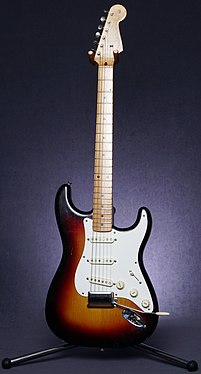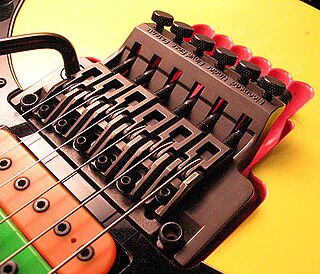| Look up tremolo or tremolò in Wiktionary, the free dictionary. |
Tremolo is a musical technique.
Tremolo may also refer to:
| Look up tremolo or tremolò in Wiktionary, the free dictionary. |
Tremolo is a musical technique.
Tremolo may also refer to:

The Kahler Tremolo System is an electric guitar bridge with a cam operated vibrato arm system. The original flat mount and stud mount models were invented and patented by Dave Storey and licensed to Gary Kahler. Gary Kahler shifted his business model to making Golf clubs in the 1990s, but went back to bridge manufacturing as of April 2005. Dave Storey went on to invent, patent, and manufacture his line of Dava guitar picks.
Tremolo, in electronics, is the variation in amplitude of sound achieved through electronic means, sometimes mistakenly called vibrato, and producing a sound somewhat reminiscent of flanging, referred to as an "underwater effect". A variety of means are available to achieve the effect. For further information about the use of tremolo in music, including notation, see Tremolo.

The Tremeloes are an English beat group founded in 1958 in Dagenham, Essex, and still active today. They were part of the British Invasion, where they grew to prominence.

Tremolo is the seventh studio album by Blue Rodeo.
TREMOLO-X is a software package used for the numerical simulation of interactions between atoms and molecules, the molecular dynamics. TREMOLO-X was originally developed at the Institute for Numerical Simulation (INS) at the University of Bonn, Germany and is evolved with the Fraunhofer Institute for Algorithms and Scientific Computing (SCAI) in collaboration with the INS.
Tremolo is a fictional mutant character appearing in American comic books published by Marvel Comics.
| This disambiguation page lists articles associated with the title Tremolo. If an internal link led you here, you may wish to change the link to point directly to the intended article. |

An effects unit or effects pedal is an electronic or digital device that alters the sound of a musical instrument or other audio source. Common effects include distortion/overdrive, often used with electric guitar in electric blues and rock music; dynamic effects such as volume pedals and compressors, which affect loudness; filters such as wah-wah pedals and graphic equalizers, which modify frequency ranges; modulation effects, such as chorus, flangers and phasers; pitch effects such as pitch shifters; and time effects, such as reverb and delay, which create echoing sounds.
Lead guitar is a musical part for a guitar in which the guitarist plays melody lines, instrumental fill passages, guitar solos, and occasionally, some riffs within a song structure. The lead is the featured guitar, which usually plays single-note-based lines or double-stops. In rock, heavy metal, blues, jazz, punk, fusion, some pop, and other music styles, lead guitar lines are usually supported by a second guitarist who plays rhythm guitar, which consists of accompaniment chords and riffs.

The Fender Stratocaster is a model of electric guitar designed in 1954 by Leo Fender, Bill Carson, George Fullerton, and Freddie Tavares. The Fender Musical Instruments Corporation has continuously manufactured the Stratocaster from 1954 to the present. It is a double-cutaway guitar, with an extended top "horn" shape for balance. Along with the Gibson Les Paul and Fender Telecaster, it is one of the most-often emulated electric guitar shapes. "Stratocaster" and "Strat" are trademark terms belonging to Fender. Guitars that duplicate the Stratocaster by other manufacturers are usually called S-Type or ST-type guitars.
Boss is a manufacturer of effects pedals for electric guitar and bass guitar. It is a division of the Roland Corporation, a Japanese manufacturer that specializes in musical equipment and accessories. For many years Boss has manufactured a wide range of products related to effects processing for guitars, including "compact" and "twin" effects pedals, multi-effect pedals, electronic tuners and pedal boards. In more recent times, Boss expanded their product line by including Digital Studios, rhythm machines, samplers and other electronic music equipment.

The Bigsby vibrato tailpiece is a type of mechanical vibrato device for electric guitar designed by Paul A. Bigsby. The device allows musicians to bend the pitch of notes or entire chords with their pick hand for various effects.
A vibrato system on a guitar is a mechanical device used to temporarily change the pitch of the strings. Instruments without a vibrato have other bridge and tailpiece systems. They add vibrato to the sound by changing the tension of the strings, typically at the bridge or tailpiece of an electric guitar using a controlling lever. The lever enables the player to quickly and temporarily vary the tension and sometimes length of the strings, changing the pitch to create a vibrato, portamento, or pitch bend effect.

Pete Loeffler is a musician, known for his work with the Chicago-area rock band Chevelle, for which he is the lead vocalist and sole guitar player.

Tremolo is an extended play by My Bloody Valentine, released in February 1991 by Creation Records. The EP was a critical success and topped the UK Indie Chart. It featured the single "To Here Knows When," which later appeared on the band's forthcoming second album Loveless in an alternate mix.

Shred guitar or shredding is a virtuoso lead guitar solo playing style for the guitar, based on various advanced and complex playing techniques, particularly rapid passages and advanced performance effects. Music critics have stated that shred guitar is associated with "fast alternate picking, sweep-picked arpeggios, diminished and harmonic scales, finger-tapping and whammy-bar abuse", while others contend that it is a fairly subjective cultural term used by guitarists and enthusiasts of guitar music. It is commonly used with reference to heavy metal guitar playing, where it is associated with rapid tapping solos, fast scale and arpeggio runs and special effects such as whammy bar "dive bombs". Metal guitarists playing in a "shred" style use the electric guitar with a guitar amplifier and a range of electronic effects such as distortion, which create a more sustained guitar tone and facilitate guitar feedback effects.
"Helpless" is a song written by Canadian singer-songwriter Neil Young, recorded by Crosby, Stills, Nash & Young (CSNY) on their 1970 album Déjà Vu.
A vibrato unit is an effects unit used to add vibrato to the sound of an electric instrument, most often an electric guitar. Vibrato units may be individual stomp boxes or built into multi-effects units, but are traditionally built into guitar amplifiers.

Peter Hayes is an American musician and singer, best known as a member of the rock band Black Rebel Motorcycle Club.

Jeff "Mantas" Dunn is a British guitarist best known as one of the founder members of seminal thrash/speed metal band Venom, with which he played as a guitarist from 1979 to 1985 and 1989 to 2002.

Luca Turilli is an Italian musician and songwriter. He is one of the founders of the symphonic power metal band Rhapsody of Fire. He also worked on a trilogy of solo albums as Luca Turilli, and released one album under the name of Luca Turilli's Dreamquest, a project he worked on alongside Dominique Leurquin. In 2008, Luca began an online guitar course titled Luca Turilli's Neoclassical Revelation. The course takes its name from his neoclassical playing style.

John Cummings is a Scottish musician and record producer, best known for being a member of Glaswegian band Mogwai, mostly playing guitar, as well as programming, keyboards and vocals.

The Ibanez Edge Tremolo is a double locking tremolo system for the electric guitar very similar in design to the original Floyd Rose. It first appeared in the Ibanez product line as of the 1986 model year; however, they have appeared on guitars with 1985 serial numbers. The Edge offers a number of improvements from the Original Floyd Rose, namely locking studs, a spring retainer on the tremolo block and a pop-in arm.
"2120 South Michigan Avenue" is an original instrumental by the Rolling Stones recorded for their second EP Five by Five. It was also released on their second US album 12 X 5 in 1964. Composer credit goes to Nanker Phelge, a title giving credit equally to all members of the band. In the book Rolling with the Stones, Bill Wyman recalls that the composition process started with him playing a bass riff and that the others followed on jamming.

A bridge is a device that supports the strings on a stringed musical instrument and transmits the vibration of those strings to another structural component of the instrument—typically a soundboard, such as the top of a guitar or violin—which transfers the sound to the surrounding air. Depending on the instrument, the bridge may be made of carved wood, metal or other materials. The bridge supports the strings and holds them over the body of the instrument under tension.